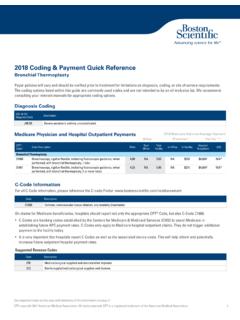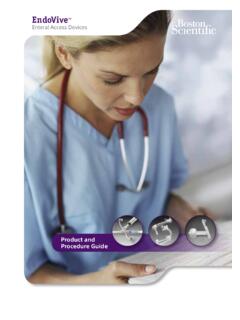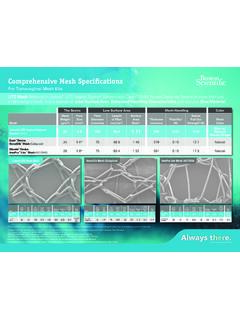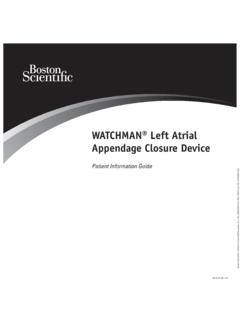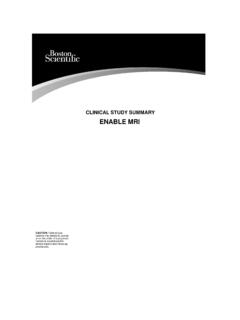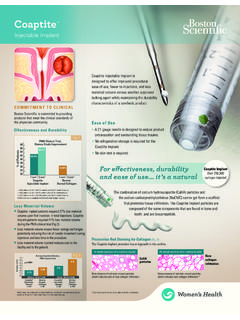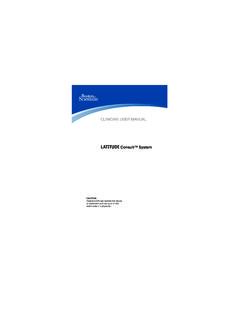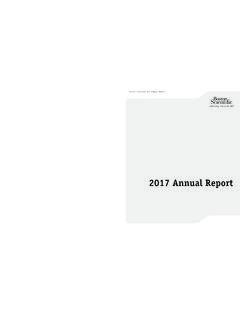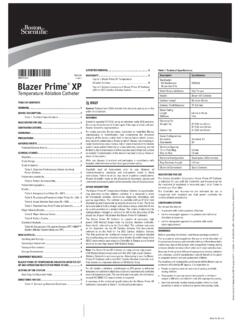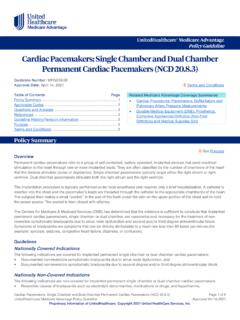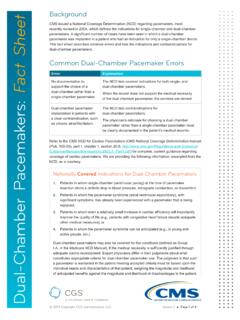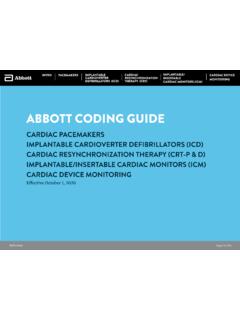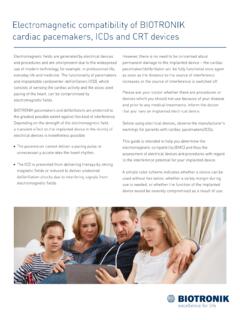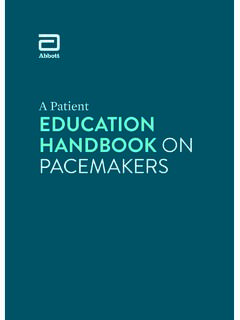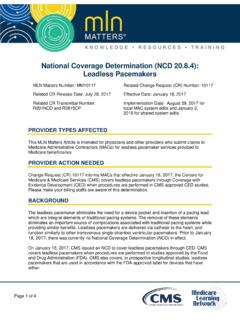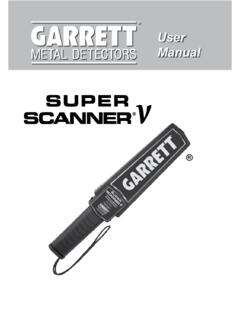Transcription of ACCOLADE MRI Pacemakers - Boston Scientific
1 Projected Longevity (Years)PacingVRDRDR-EL50% RA/RV 100% RA/RV Specifications and Reimbursement Information Size (cm) Connector Type Model Type (W x H x D) Mass (g) Volume (cc) (RA RV LV) C-Code L310 VR x x RA/RV: IS1C1786 L311 DR x x RA: IS1 RV: IS1C1785 L331 DR-EL x x RA: IS1 - RV: IS1C1785 Settings: pacing pulse width , Impedance 500 , LRL 60bpm, Sensor On, EGM Onset On. These calculations also assume that the pulse generator spends 6 months in Storage mode during shipping and storage, the Zip telemetry use for 1 hour at implant time and for 40 minutes annually for in-clinic follow-up checks. For longevity calculations based on different settings please contact Boston Scientific technical services or your local representative. Power Supply VR and DR models: lithium-carbon monofluoride cell; Boston Scientific ; 402290.
2 Power Supply DR-EL: lithium-carbon monoflouride cell; Boston Scientific ; Longevity InformationACCOLADE MRI PacemakersStandard Models: L310 and L311 Extended Life (EL) Model: L331 Use with the INGEVITY MRI Pacing Lead provides an ImageReady MR-Conditional Pacing System1 Full body scan , First level controlled operating mode (SAR 4W/Kg) No MR exclusion zones, no height restriction MRI Time Out Mode to return patient to orginal pacemaker settings after scan Automatic Daily Monitoring with the LATITUDE NXT Patient Management System, to improve clinic efficiency and provide a higher level of care for device patients2 Available in both standard and EL models Industry-leading projected longevity projected to last over 12 years with ACCOLADE MRI EL3-5 Advanced diagnostic reports provide a comprehensive and proactive approach for comorbidity management RF telemetry for wireless transmission of information and efficiency in the operating room and follow-up setting PaceSafe RV and RA, providing dynamic adjustment of pacing outputs to ensure capture and maximize efficiency RightRate with the MV sensor.
3 The only MV sensor clinically proven to restore chronotropic competence6 RHYTHMIQ , designed to minimize unnecessary RV pacing without clinically significant pauses, therefore reducing the risk of HF development7 Enhanced features and diagnostics, including Respiratory Rate Trend, designed to provide you with greater insight into your patient s disease progression based on the patient s own respiration Post Operative System Test (POST) to facilitate patient follow-up with a fully automatic device and lead check EasyView header with port labels (on DR device) designed to make the implant experience more efficient ACCOLADE MRI PacemakersStandard Models: L310 and L311 Extended Life (EL) Model: L331 Pacing TherapyBrady ModesNormal:DDD(R)-DDI(R)-VDD(R)-VVI(R)- AAI(R)-DOO-VOO-AOO-Off Temporary: DDD-DDI-VDD-VVI-AAI-DOO-VOO-AOO-OffAT/AF ManagementATR Mode Switch, Ventricular Rate Regulation (VRR), Atrial Flutter Response (AFR), Rate SmoothingAutomaticityAutomatic Gain Control (AGC) for sensitivityRight Atrial Automatic Threshold (RAAT)Right Ventricular Automatic Capture (RVAC)Rate Adaptive PacingAccelerometer, RightRate (Minute Ventilation) or blended sensors with sensor trending functionRV Pacing ReductionAV Search +, RYTHMIQ , AV Delay to 400 ms, Rate HysteresisRate ManagementSudden Brady Response (SBR), PMT Termination, PVARP after PVC, Dynamic PVARPPace/Sense ConfigurationUnipolar, Bipolar, Bipolar/Unipolar, Unipolar/Bipolar, Unipolar/Off, Bipolar/Off, Lead Safety SwitchImplant/In Clinic Follow UpImplant Communication ModeProgrammable values.
4 Enable use of ZIP telemetry (MICS) (Requires initial use of wand for device ID) or use wand for all telemetryNominal: Enable use of ZIP telemetry (Requires initial use of wand for device ID)In Clinic Follow UpSnapshot Function up to 12 seconds trace of ECG/EGM display storedPOST (Post-Operative System Test): provides an automatic device/lead check at a pre-determined time post-implant to help document proper system functionality without requiring manual system testingIndications-Based Programming (IBP)Tool that provides specific programming recommendations based on the patient s clinical needs and primary indicationsPatient DiagnosticsArrhythmia LogbookEvent Summary, Stored Electrograms with Annotation Markers (Intervals and approximately 14 minutes all multi channel EGM, always with 10 seconds Onset and event storage prioritization).
5 Implant activation of all available EGMs. On screen measurements of all stored signal, amplitudes and timing. Snapshot Function (up to 12 seconds trace of ECG/EGM display stored)Histograms & CountersVentricular Tachy Counter, Brady Counter, Histograms, Intrinsic Promotion (Rate Hysteresis % successful and AVSH+ % successful) Therapy/DiagnosticsHeart Rate Variability (HRV) with SDANN and ABM, Respiratory Rate Trend, AT/AF Burden, Activity Level, A & V Arrhythmias, Weight and Blood Pressure8 Atrial Arrythmia ReportAT/AF% and Total Time in AT/AF, AT/AF Burden Trend, RV Rate during AT/AF Trend, Pacing Percent Trend, Heart Rate Trend, Activity Level and Respiratory Rate Trends, RV Rate during AT/AF Histogram. Timeline history of interrogations, programming, and counter resets for one year. Longest AT/AF, Fastest RVS rate in AT/AF, and most recent TREND for last 365 DaysEvents, Activity Level, AT/AF Burden, Pacing Percent, Respiratory Rate, Heart Rate, SDANN, HRV Footprint, ABM, Lead Impedance and Amplitude, RAAT Trend, RVAC TrendRemote Follow UpRemote MonitoringThis device is designed to be LATITUDE NXT enabled.
6 LATITUDE NXT availability varies by regionThresholdsAutomatic storage of last successful daily PaceSafe threshold test for all active chambersWirelessRemote follow-up for all devices (MICS)Patient Triggered Monitor (PTM)Triggers the storage of two minutes onset and one minute post EGMs, intervals, and annotated marker data during a symptomatic episode by placing a magnet over the deviceSafety Functions9 Safety CoreIs intended to provide life-sustaining therapy if certain non-recoverable or repeat fault conditions occur. Safety Core operates independently and acts as a backup to these componentsElectrocautery Protection ModeProvides asynchronous pacing at the programmed outputs and LRL when commanded by the programmerImageReadyTM MR-Conditional Pacing SystemMRI Lead SelectionPulse Generator MR-Conditional with all INGEVITY MRI pacing lead models MRI Conditions Full body scan at , First Level Controlled Operating Mode (</- SAR 4w/Kg) for all INGEVITY MRI lead models1 MRI Mode Pacing Mode: AOO, VOO, DOO, OffProtection Mode Time Out: Off, 12,24,48 hours Rhythm Management300 Boston Scientific WayMarlborough, MA ( )Patients and 2016 Boston Scientific Corporationor its affiliates.
7 All rights APR2015 All trademarks are the property of their respective Please refer to the MRI Technical Guide: ImageReadyTM MR Conditional Pacing System as the system is designated as MR Conditional in accordance with specific This device is designed to be LATITUDE NXT enabled; LATITUDE NXT availability varies by region. 3. Boston Scientific ACCOLADE pacemaker Physician s Technical Manual 359246-001 EN US Medtronic Advisa DR MRI SureScan A2DR01 Clinician Manual. M950432A001E St. Jude Medical Accent MRI pacemaker Rep to Clinician PPT. ~ Accessed 1/10/14. 6. Chronotropic competence is defined by the Model of the Cardiac Chronotropic Response to Exercise. Wilkoff B, Corey J, Blackburn G. A mathematical model of the cardiac chronotropic response to exercise. Journal of Electrophysiology. 1989;3:176 180.
8 Refer to the Physician s System Guide for more information on adaptive-rate therapy. Additional clinical performance was assessed using INSIGNIA Ultra clinical data with the AutoLifestyle feature programmed On. Boston Scientific . Data on file. ALTRUA pacemaker System Guide. 2008;1:20 Full Interrogations (scheduled remote follow ups, and quarterly patient-interrogations).7. Boston Scientific Clinical Summary Ivory Study 358487-019 EN US 2012-108. Weight and Blood Pressure are only available via LATITUDE The Safety Functions do not have programmable Systems from Boston Scientific : ACCOLADE , ACCOLADE MRI, PROPONENT , PROPONENT MRI, ESSENTIO , ESSENTIO MRI, ALTRUA 2, FORMIO , FORMIO MRI, VITALIO , VITALIO MRI, INGENIO , INGENIO MRI, ADVANTIO INDICATIONS AND USAGE: Boston Scientific Pacemakers are indicated for treatment of the following conditions.
9 Symptomatic paroxysmal or permanent second- or third-degree AV bloc Symptomatic bilateral bundle branch block Symptomatic paroxysmal or transient sinus node dysfunction with or without associated AV conduction disorders ( , sinus bradycardia, sinus arrest, sinoatrial [SA] block) Bradycardia-tachycardia syndrome, to prevent symptomatic bradycardia or some forms of symptomatic tachyarrhythmias Neurovascular (vaso-vagal) syndromes or hypersensitive carotid sinus syndromes. Adaptive-rate pacing is indicated for patients exhibiting chronotropic incompetence and who may benefit from increased pacing rates concurrent with increases in minute ventilation and/or level of physical activity. Dual-chamber and atrial tracking modes are also indicated for patients who may benefit from maintenance of AV synchrony. Dual chamber modes are specifically indicated for treatment of the following: Conduction disorders that require restoration of AV synchrony, including varying degrees of AV block VVI intolerance ( , pacemaker syndrome) in the presence of persistent sinus rhythm Low cardiac output or congestive heart failure secondary to bradycardiaCONTRAINDICATIONS: These Boston Scientific Pacemakers are contraindicated in patients who have a separate implanted cardioverter defibrillator (ICD) with transvenous leads.
10 Use of certain pacing modes and/or features available in these Boston Scientific Pacemakers is contraindicated for the following patients under the circumstances listed: Unipolar pacing or use of the MV Sensor with a Subcutaneous Implantable Cardioverter Defibrillator (S-ICD) because it may cause inappropriate therapy or inhibition of appropriate S-ICD therapy. Minute Ventilation in patients with both unipolar atrial and ventricular leads Single-chamber atrial pacing in patients with impaired AV nodal conduction Atrial tracking modes for patients with chronic refractory atrial tachyarrhythmias (atrial fibrillation or flutter), which might trigger ventricular pacing Dual-chamber and single-chamber atrial pacing in patients with chronic refractory atrial tachyarrhythmias Asynchronous pacing in the presence (or likelihood) of competition between paced and intrinsic rhythmsWARNINGS: General Read the manual thoroughly before implantation to avoid damage to the pulse generator and/or lead.
